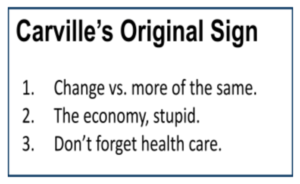How not Why is the Question
Fans of political campaigns might recognize the phrase, “It’s the economy, stupid,” as James Carville’s strategy for the 1992 Clinton campaign. The iconic phrase is actually a misquote of one of the phrases Carville coined to keep the Clinton presidential campaign team on message. It’s a simple statement that encompasses a wealth of ideas. It is easy to remember and it’s direct. It probably helped Clinton win the campaign. Why? Carville had tapped into the power of putting the right message in front of the right audience at the right time. That’s the classic definition of why content marketing works!
Recently, a content marketing newsletter reminded me of the power of simple explanations for complex ideas. The newsletter had a story about a CEO asking his CMO, “How does content marketing work?” It’s a straightforward question. There should be a simple, direct answer. How would you answer if your CEO asked you that question? If your go-to answer is to define content marketing or to explain your current strategy, you’ll fail, just like the hapless CMO who talked around the question.
As digital marketers, we all know what content marketing is, but are we paying attention to exactly how it works? We believe in it, and we use data to tell us what’s working. So we do more of it. Bloggers push out gazillion words because we say the blog is working. Brands pursue their audiences relentlessly with nonstop content on every social media platform. Take a hard look at your personal Facebook or Instagram feed. Now count how many brand and promoted posts appear in your feed. Then count how many personal updates from actual friends you see. If your account is like mine, you’re seeing more branded content and ads than personal posts. Why? Because content marketing works on social media and elsewhere! But that doesn’t tell us how it works.
Stage Makeup is Content Marketing
Let’s back up for a moment. I spent three decades in higher education teaching a skills-based stage makeup class. Over the course of a semester, students had 8-10 makeup assignments. Each one was graded. Each assignment was focused on a specific set of skills. In order to demonstrate mastery of the skill, students needed to master the principle of highlight and shadow. Spoiler alert: The art of makeup is essentially the art of highlights and shadows!
Inevitably, the work for the first assignment was flat and generic. Students followed textbook examples without really understanding the key principle. The guys did what they saw others doing. The girls followed their habitual makeup application. When they understood how highlights and shadows create the desired illusion, they could create magic.
It’s the same for content marketing.
Content marketing is so ingrained in the marketing ecosystem, no one thinks twice about it. But how does it work?Click to PostIt’s the Audience
When you stop and think about it, the concept of content marketing is so ingrained in the entire marketing ecosystem that no one thinks twice about it. Businesses assume they need it. Budgets to produce content are allocated ranging from shoestrings to more than $50,000 per month for the big brands. A 2021 Forbes article advised B2B companies to allocate 25-30% of the marketing budget to content. Why? Because it works.
Studies show content marketing gets three times the leads per dollar spent compared to paid search. Content marketing is credited with generating three times the number of leads and at a 62% lower cost than outbound marketing. How does it do that?
The answer is that content marketing gives your audience the power to pick and choose the type of information/content they consume when they want it and where they want to see it.
Audience Choices, not Brand Choices
It really is all about the audience. They decide what information they want. They choose where they look for that information. Consumers decide how much information they want to consume. And it’s up to them to choose what their next step will be. More importantly, their paths are nonlinear and multichannel. They control the conversation.
The conversation might begin with a digital search. But don’t assume they’re using Google search. If they want to buy something, chances are they’re using Amazon as a search engine. They might be using Bing, Yandex or DuckDuckGo. They could be looking for inspo on Pinterest or checking out informative YouTube videos, both of which consider themselves to be search tools. So, if brands want to be part of the convo, they have to be on the right platforms with the right content. Choosing what to provide and where to offer it in order to convert consumers to users is what content marketing strategy is all about. The answer to the question is simple: Content marketing works because the audience drives the conversation.
Put “How” to Work for You
Traditional marketing is a push system. Brands decide what matters and broadcasts it to consumers. The mediums used for delivery are the brand’s choice. Digital content marketing is a 180。from that old-school approach. Consumers decide what, where, when, and how to consume the proffered information. They’ve expanded their definition of what’s useful to know if they’re making a purchase. Their search might take them from a consumer-focused article to a review site to branded websites with product specs. They might bounce back and forth between social posts trying to see it as part of their lives. They’ll probably move from general, informative articles to asking more and more specific questions. They research and discard a variety of options and product iterations as they narrow their choices.
But no matter what content they’re searching for and consuming, brands need to understand that the only useful content is content that serves the needs of the audience. If you’re wondering if your content is consumer-focused or brand-focused, it’s time to talk to one of EVG’s experts. We understand how content marketing works.



